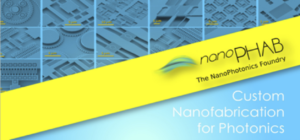We asked Dr. Maurangelo Petruzzella, CTO of the recently founded startup nanoPHAB, based in Eindhoven (NL) a few questions :
- Please tell us about your company and how it relates to Nanoscale quantum optics.
NanoPHAB is a novel pure-play fabrication foundry that provides fabrication services to research groups and small- and medium-sized enterprises active in micro- and nano-photonics and semiconductor technologies. The manipulation of light at sub-micron scales requires components featuring challenging specifications in terms of critical dimensions, materials and electro-optical properties. The necessary expertise and the high costs involved in the fabrication of these devices currently prevent many fabless research groups to investigate potentially groundbreaking concepts. On the other hand, the transition from proof-of-principle samples to the medium-scale production of devices suitable for commercialization is a challenging task. In this respect, nanoPHAB might represent an efficient solution to COST members for prototyping custom nanophotonic devices based on different materials (III-Vs, silicon, glass and polymers) and an important partner to covert an idea into a commercial product.
- What industrial perspective do you see for quantum technologies in the next few years?
Quantum technologies are a game-changer in many fields. By exploiting the intrinsic parallelism offered by superposition and entanglement, they will provide new fundamental paradigms in solving computationally-hard problems, in sensing, in creating physically-secure communication channels within the future quantum internet. These are crucial topics in the current information era and have already attracted investments of large enterprises and governments, competing to achieve a quantum advantage over classical solutions. Although future technologies might not have the same dissemination of general purpose computers and smartphones, they have great potential to disrupt many existing markets. Besides, quantum engineering often demands solving a number of problems and implementing novel schemes potentially beneficial also for classical technologies.
- How do you think the Nanoscale Quantum Optics COST Action can help your company, and how industries can contribute to the Action?
Despite some notable examples in recent years, the commercialization of many quantum photonics technologies is still in its infancy. Many difficulties arise when the proof-of-principle experiment of a future technology is demonstrated and its transition to the market is not trivial. The COST network can provide a direct and bidirectional link between academia and industry, which will benefit the entire photonic and nano ecosystem through a knowledge spillover. From one side, the development phase essential for many quantum applications cannot be carried out within the capabilities of single universities. The partnership with industrial members able to protect the intellectual properties of researches can provide an effective way to further develop the core of the technology and a pathway towards the commercialization step. On the other side, industries working on cutting-edge technologies continuously demand highly-trained personnel that only research centers can generate. COST action might enhanced the connections between these two worlds and promote the implementation of a decentralized technology hub.
26.01.2018
